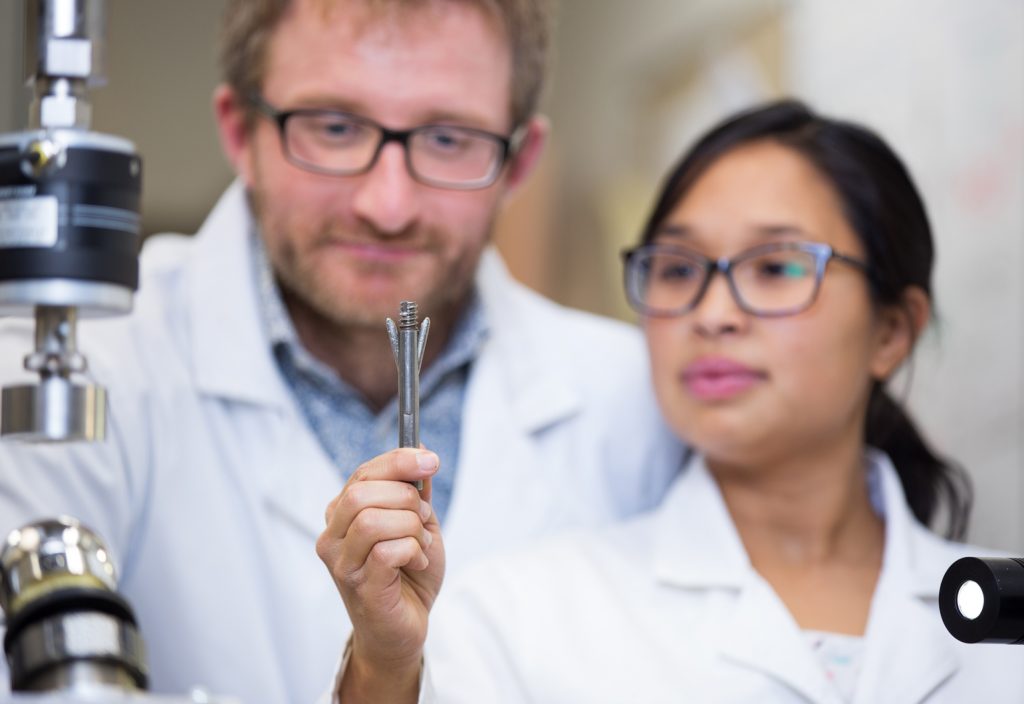One in 10 complex hip surgery patients have to return to hospital due to orthopaedic screws coming loose. This orthopaedic screw could change that.
A research team of biomedical engineers from Curtin University has come up with a new orthopaedic screw that could not only lift the burden on the health care system, but also improve the lives of patients.
One of the main problems with current screws is that they either come loose or cut through the bone and damage the joint, or are hard to remove.
But a key advantage of the REX Orthopaedic Screw is that it prevents the bone from growing around it, which means it can be more easily removed and result in less damage to the bone.
“The main difference between a normal orthopaedic screw is that our screw expands,” said Matthew Oldakowski, research associate of the School of Civil and Mechanical Engineering at Curtin University.
“By expanding it, it increases the size of the screw at the tip, and this increases the resistance when the bone is trying to push the screw out.”
Taking it for a spin
The screw comprises an outer and inner part – when a surgeon removes the inner expandable part, the outer part remains.
So far, the team has carried out simulations to test the strength of the screw using synthetic bone and simulating a hip fracture, testing different geometries and their elastic response.
It also carried out other testing to create different designs using laser cutting, as well as CT scanning of the material to show that the screw has retracted completely and has a full elastic response.
Tests included putting the REX Screw into synthetic bone, along with the main competitor’s screw, and cycling it until the screw worked its way through and poked through the joint.
“This typically took about 1000 cycles, so it took about half an hour for the sample to fail,” Oldakowski said.
“We’ve gone head-to-head against the competitor’s. We’ve shown that our screw can survive on average more than five times longer than the competition’s screw before it pokes through the bone and damages the joint.”
One reason was the expansion capabilities of the screw, which increases the surface area of the screw and bone; the more surface area of bone that connects with the screw, the less pressure there is on the bone, which means it takes longer to fracture.
Challenges
In the beginning, the team started with 3D printing with titanium, testing about 25 different designs until it worked out a simpler way using mass manufacturing methods.
During this process, the main technological challenge was making it removable.
Oldakowski said in the past, researchers have taken common designs for expandable wall fixes such as DynaBolts and tried to use them in orthopaedic applications, but these bolts weren’t designed to be removed.
Another challenge was bone growing into the roughness of metals such as stainless steel and titanium in orthopaedic applications, which makes it difficult for surgeons to remove screws once they’ve been in the body for a long period of time.
However, the REX Screw avoids this due to its design and the fact that it doesn’t have any gaps within the outside of the mechanism, which doesn’t leave space for the bone to grow into it.
Another challenge was manufacturability, with the team factoring in the cost of goods into their design.
“Whenever you add complexity, you add costs to the manufacturing, and that cost is unattractive to manufacturers,” Oldakowski said.
“So we needed to try and walk the line between having the design effective enough to be removable, but cheap enough to manufacture. That’s where a lot of our value is – our design does both of those things.”
Retractable arm
The current retractable arm mechanism has developed over time from a square shape to the current circular shape – the team initially started working in the shoulder and spine, where the screws were smaller, which limited the team in terms of conventional manufacturing and complexity.
When the team moved into the hip, the screws were about twice as big, which gave it more freedom.
“We went complex, and then we realised we could become simple again,” Oldakowski said.
“By heading towards complexity, we were able to get somewhere that was even simpler than where we came from.”
But the challenge of a circular design involved how to ensure it remained flexible, which the team overcame by reducing the number of arms in the screw and having sections that didn’t expand.
Over the next 12 months, the team plans to carry out cadaver studies in legs, which Oldakowski expects to be completed by Christmas.
It will then move onto animal studies mid-next year in collaboration with Murdoch University, where it will implant them into sheep for 12 weeks to show the screws can be easily removed and demonstrate that the design is safe.
